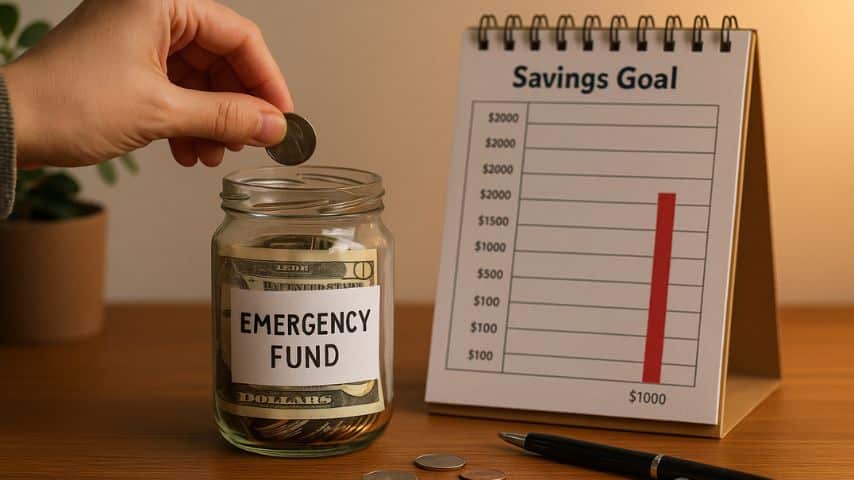How to Stay Consistent and Reach Your Emergency Fund Goal

Building an emergency fund is arguably the most critical step in achieving true financial security. This financial safety net—typically 3 to 6 months' worth of living expenses—acts as a critical buffer against life's inevitable curveballs, such as unexpected medical bills, sudden job loss, or essential car repairs.
While the concept is simple, the execution—staying consistent and reaching that often daunting multi-thousand-dollar goal—is where most people stumble. It’s not about finding one giant lump sum; it’s about mastering the art of financial consistency. This detailed guide will break down the process into actionable steps, focusing on unique strategies and the power of habit to ensure you not only build your fund but also maintain it.
Part 1: Setting the Stage for Success
Before you can be consistent, you need a crystal-clear, realistic target and the right environment for your money to grow.
1. Calculate Your True Goal
The standard 3-6 months is a good starting point, but you need to personalize it.
- Determine Your Essential Monthly Expenses: Go through your bank statements and sum up only your non-negotiable costs: rent/mortgage, minimum debt payments, utilities, groceries, insurance, and essential transportation. Exclude discretionary spending like dining out, entertainment, and non-essential subscriptions.
- Define Your Safety Cushion: Multiply your essential monthly expenses by 3, 4, 5, or 6. If you have a highly stable job (e.g., government, tenured position) or a second household income, 3 months might suffice. If you're a freelancer, have a single income, or own an older car/home, aim for 6 months or more.
- The "Mini-Goal" Strategy: Seeing a $15,000 goal is overwhelming. Break it down. Your first goal is to save $1,000. This "starter fund" is surprisingly effective at stopping debt before it starts. Once you hit $1,000, your next goal is one month of expenses, and so on.
2. Isolate Your Funds in a High-Yield Environment
One of the biggest consistency killers is temptation. Your emergency fund cannot live in the same checking account you use for daily transactions.
- Open a Dedicated High-Yield Savings Account (HYSA): HYSAs offer significantly better interest rates than traditional savings accounts, meaning your money is actively growing (albeit slowly) while it sits. Look for an account at an entirely separate institution from your main bank.
- Benefits of the HYSA:
- Higher APY: Accounts from institutions like Vio Bank, Jenius Bank, or Marcus by Goldman Sachs often offer APYs significantly above the national average (in 2025, rates can exceed 4.00%). This provides a small, consistent reward for saving.
- Out of Sight, Out of Mind: The slight friction of having to log into a separate bank's app or initiate an external transfer is often enough to deter you from dipping into the fund for a non-emergency expense, protecting your consistency.
Part 2: The Consistency Engine: Automation and Habit Stacking
Consistency is not a measure of willpower; it’s a product of a smart system. You need to remove decision-making from the equation.
3. Automate Your Contributions Like a Robot
This is the single most powerful tool for consistency.
- "Pay Yourself First": Set up an automatic transfer for a specific amount to move from your checking account to your emergency fund HYSA the day after your paycheck hits. Treating this transfer like a fixed, non-negotiable bill (like rent or car payment) fundamentally changes your mindset.
- Start Small, Then Scale: If you can only afford $50 per paycheck right now, that's fine. Automate the $50. The consistency is more important than the amount in the beginning. As you pay off debt or get a raise, immediately increase the automated transfer amount before you get used to spending the extra money.
4. Implement Habit Stacking for "Found Money"
Consistency isn't just about monthly transfers; it's about capturing irregular, unexpected cash flow. This is where "habit stacking" helps.
- The $5 Bill Rule: Every time you receive a $5 bill in cash, transfer it immediately (or once a week) to your emergency fund.
- The Coupon/Savings Rule: Whenever you save money using a coupon, store points, or by successfully negotiating a bill (like cable or insurance), immediately transfer 50% of the saved amount to your emergency fund.
- The Windfall Rule: Any unexpected income—a work bonus, tax refund, or cash gift—must be split. A dedicated percentage (e.g., 50% or 75%) goes straight to the emergency fund before you spend the rest. This creates powerful, non-recurring contributions that drastically accelerate your timeline.
Part 3: Maintaining Momentum and Mindset
The psychological battle against financial temptation is crucial for long-term consistency.
5. Define Your Emergency (The 'Three-Question Test')
Your consistency will crumble if you use your fund for non-emergencies (like a spontaneous vacation or a new gadget). You need a strict policy. Before dipping into the fund, ask yourself these three questions:
- Is it Unforeseen? Did I know about this expense last month? (e.g., car insurance is not unforeseen; an emergency roof repair is.)
- Is it Essential? Is this necessary for my health, safety, or ability to earn income? (e.g., a broken furnace in winter is essential; a new TV is not.)
- Is it Urgent? Does this need to be dealt with now, or can it wait until the next paycheck? (e.g., a cracked tooth is urgent; a desire for new furniture is not.)
If you can't answer "Yes" to all three, it is not an emergency, and you must leave the fund untouched.
6. Track, Visualize, and Reward Progress
Humans are motivated by visible progress. If you just see a number in an account, it feels abstract.
- The Visual Tracker: Use a physical or digital tracking tool (like a printable coloring chart or a spreadsheet) to visually show your progress towards the goal. Fill in a section for every $500 or $1,000 saved. This creates a psychological reward loop.
- The Consistency Check-In: Dedicate five minutes every two weeks to check the fund's balance. This simple act reinforces the importance of the goal and allows you to catch any errors in automation or unauthorized withdrawals early.
- Celebrate Milestones (The "Small" Rewards): Do not reward yourself with an expensive purchase that depletes your momentum. Instead, for every $2,000 saved, reward yourself with a small, budget-friendly celebration, like a favorite takeout meal or a dedicated streaming movie night. This recognizes your effort without compromising the goal.
7. Replenish Instantly After a Withdrawal
The consistency challenge doesn't end when you hit your goal; it ends when you use the fund. The immediate aftermath of an emergency can break your consistency if you don't have a plan.
- Create a Replenishment Plan: If you have to use $2,000, your new financial goal is immediately to get the fund back to its previous full balance. Increase your automatic contribution for a set period, implement an aggressive "no-spend" month, or temporarily pick up a side gig. Treat this replenishment as the most urgent financial priority until the fund is whole again.
Conclusion: The Power of the Small Start
Reaching a multi-month emergency fund goal can take many months, or even years. The secret to staying consistent is removing willpower from the equation by automating your savings, creating friction against withdrawals, and celebrating the smaller, consistent steps along the way.
Remember, the greatest financial benefit of a fully funded emergency cushion isn't the money itself, but the peace of mind it provides, allowing you to handle a crisis without incurring high-interest debt. Start today, start small, and let the power of automation build your financial fortress, one consistent step at a time.

Related